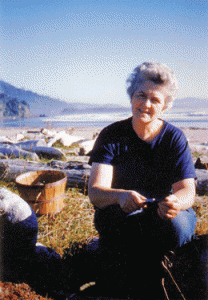The LuRon Story
Lucile Worlund’s Tale
The life of Lucile Worlund is the story of the beginning of the LuRon method of driftwood sculpture. Lucile lived for 35 years in Portland, Oregon, then moved with her young son Ron to the Seattle area. She learned about the City Heights Boys Ranch owned by some friends. She was interested in having her son attend the school and soon became the house mother at the ranch. Her duties were varied and creative, keeping the boys happy and occupied with hobbies, taking part in rodeo shows at the ranch, organizing trips to the beaches and going with them to nearby lakes and mountains collecting all kinds of nature’s treasures. This was an incentive for the boys to make gifts from what they collected to give away or to sell for extra spending money and merits. With a good supply of collected driftwood, Lucile taught the boys to clean the wood and make totem poles.
Lucile and young Ron lived in the cabin near the ranch during this time. Soon Lucile met and married her new husband, a customs officer. They were married at the ranch and they continued to live there until he was transferred to Neah Bay on the Makah Indian reservation in 1952. Lucile decided that all the beautiful driftwood on the beaches could surely be made into art objects with a bit of cleaning and burnishing. Her first tools were just a jackknife, a four-way rasp, sandpaper made from the dried skin of a shark and a deer antler. The Makah taught her how the antlers were used in burnishing wood by showing her trees the deer used to scrape their antlers, which made the bark shine. Soon she was teaching the tribal children how to finish driftwood into beautiful sculptures during which time she perfected this art.
After six years, in 1958, the family returned to Seattle and Lucile refined and developed her method of working wood. Her sculptures became increasingly beautiful and very desirable. Her son, now a doctor, took the first two letters of her name, added three of his own and as a present to her, registered this name as their trademark in 1977. This process took him four years and two months to accomplish.
After her return to the Seattle area, Lucile began teaching classes in driftwood sculpture. First at the YMCA in 1962 then at local colleges and arts centers. The first driftwood sculpture art show was held at the Bothell Art Barn in 1963. Many students came for her classes. Her tools expanded to include the X-Acto router blades and handles and the first meeting of the Northwest Driftwood Artists (NWDA) was held November 6, 1963. Those attendees became the charter members of the organization that now has over 100 members. Bylaws were established, rules concerning the quality of work, the standards of this new art form, and qualities determining its finishes were decided.
Lucile continued to be a consistent driving force: Teaching classes and helping new teachers and establishing the LuRon Driftwood Sculpture Teachers in 1977. Their goal was to uphold the standards of this unique art form she developed.
Lucile retired from teaching in 1978 and in 1986 the members honored her for her 34 years of inspirational guidance and for sharing her concept of the “seeing eye.”
The “seeing eye” involves choosing a suitable piece of wood, recognizing the pattern inherent in that wood, exposing the beauty by creating a balance of shape pleasing to the eye, and finishing the piece with excellence.
Lucile Worlund passed away in 1989, leaving a wonderful, timeless, and lasting legacy of exquisite sculptural achievements.

